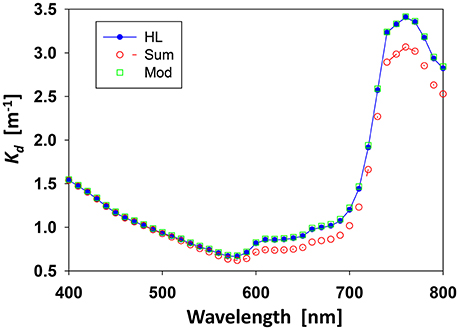BPL assumption: in 4SM, we derive operational spectral diffuse attenuation coefficient 2K for remote sensing radiance - using Jerlov's table of diffuse attenuation coefficients for downwelling irradiance in water under clear sky conditions, sun high in the sky.
- See quotations by Jerlov, and by Kirk.
|
Ki/Kj : for this, we estimate the ratios Ki/Kj from all visible bands i and j in the image, using a protocole slightly modified from Lyzenga. - Note that one must ensure that Ki/Kj =(Ki/Kk)/(Kj/Kk).
- This turns out to be a sensitive requirement over the Yellow-Red range.
|
| The ratio Kblue/Kgreen is then used to interpolate operational spectral K for all visible bands, as suggested by Kirk. Note that one needs to specify the operational spectral wavelength for all visible bands. |
| Mid-waveband: by default, one commonly uses the wavelength at mid-waveband, although there is room for accounting for the specific radiance response curve of each wideband. |
| Two-ways : we then use 2K in the simplified radiative transfer equation |
So we expect that coefZ~=1 in FinalZ=coefZ*RetrievedZ - Htide, - i.e. no need for field data!
- wavelenths at mid-waveband
- coefZ~=1
- 2K in units of m-1
- Z in units of m
- L, LB and Lw in native image DNs, as this is a "ratio" method:
- no need to convert into units of reflectance (0-1)
|
Achieving a good fit in optical calibration diagrams
requires decreasing 2K in the 0-~10 m depth range,
i.e. in the Yellow-Red range
in line with Jerlov's statement
Then maybe: no need for field data!
|


















